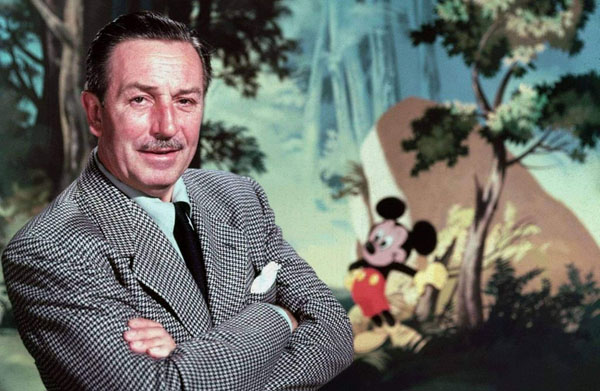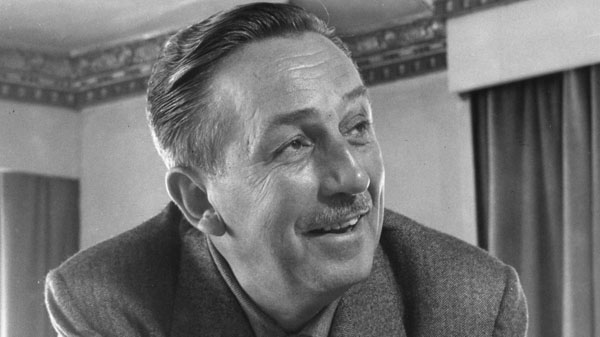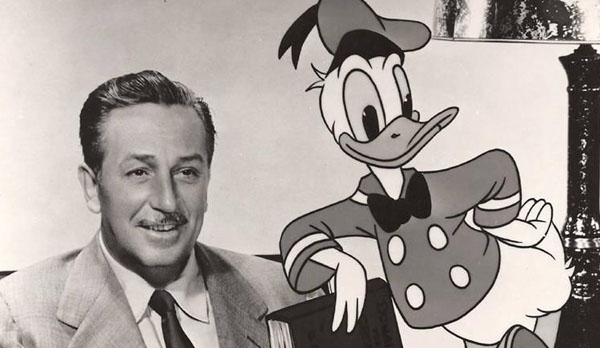
Suspended Animation #332
Over the decades, I have collected quotes by Walt Disney from magazines, newspapers, interviews and more. Here are a few that relate to animation that readers may not have seen or may not remember:
“In Kansas City, when I became seriously interested in cartooning, I gained my first information on animation from a book written by E.C. Lutz which I procured from the Kansas City Public Library.” – Letter from Walt Disney to Miss Irene Gentry of the Kansas City Library in Missouri August 17, 1937
“I’ve often been told how lucky I am not to have any stars to go temperamental on me. It’s true I never have any trouble with Mickey, the three pigs or any of my characters. But don’t ever think animators can’t be temperamental. Say, they can be just as bad as any star you ever saw.
“Occasionally one will have an off day on which he can’t draw anything worth while. Then he has to be pampered and pulled out of his slump with all the diplomacy that would be used on coaxing a (movie) star.” – Odgen Standard Examiner newspaper May 12 1935
“I never show a bad cartoon from another studio. That tends to make everybody here get fat and lazy and smug. But when they see a good one somebody else has made they charge out and work twice as hard.” – “Walt Disney Spurning $8 Million in TV Offers” for the United Press International with reporter Virginia MacPherson December 18, 1952
“No matter how good a picture we turn out, I can always see ways to improve it, when it’s too late. So I try to put the idea to work in the next picture. I’m just as amazed at the success of our cartoons as anyone else. Sometimes I pinch myself to make sure I’m not dreaming.” – “What Has Disney Got that We Haven’t?” by Frank Taylor The Commentator magazine October 1938

“We kept fooling around with the Silly Symphonies until we came up with ‘The Three Little Pigs’ (1933). I could not possibly see how we could top pigs with pigs. But we tried, and I doubt whether one member of this audience can name the other cartoons in which the pigs appeared.” – Walt Disney’s speech accepting the Showman of the World Award from the National Association of Theatre Owners October 1, 1966
“The Plausible Impossible means taking something that is against the laws of nature – something impossible –and make it appear rational and acceptable – in short, plausible. Impossible cartoon actions will seem plausible if the viewer feels the action he’s watching has some factual basis.” – Walt’s introduction to the television episode “The Plausible Impossible” (10/31/56)
“Because the animated cartoon comes to life of the screen, it belongs in the field of the motion picture. But because it is drawn and painted, it is also one of the graphic arts like painting. As a matter of fact, it is often referred to as the last of the graphic arts.” – Walt’s introduction to the television episode “Tricks of Our Trade” (2/13/57)
“We try to get something in the cartoon besides just nonsense. We have to be careful not to get the sketches too silly.” – “How Silly Symphonies and Mickey Mouse Hit the Up Grade” by Florabel Muir in the New York Sunday News December 1, 1929
“We had decided there was only one way we could successfully do Snow White (1937) and that was to go for broke — shoot the works. There would be no compromise on money, talent or time. We did not know whether the public would go for a cartoon feature; but we were damned sure that audiences would not buy a bad cartoon feature.” – Walt Disney’s speech accepting the Showman of the World Award from the National Association of Theatre Owners October 1, 1966
“For years we got by on ‘shorts’—borrow some money and make a ‘Mickey’ or a ‘Duck’ and then pay off enough to borrow some more. Animated cartoons are more expensive to make than live-action films. Where they pay off is on revivals. Every seven years they come back for a new audience. And they don’t date like live action does.” – “Citizen Disney” by Arthur Miller for Los Angeles Magazine November 1964.

“It was always my inclination to think in pictures rather than words. I was already dreaming of becoming an artist. I spent many study hours in elementary school drawing flip-over figures on textbook margins – like the McGuffey readers – to entertain classmates.” – The California Teacher Association Journal December 1955
“The trick of creating a cartoon character with a real personality requires something more than proper movement. In order to really come to life, the character’s actions must appear to come from his own thoughts and feelings. In other words, a cartoon character must seem to have a cartoon brain. For only thinking characters can become a personality.” – Walt’s introduction to the television episode “Tricks of Our Trade” (2/13/57)
“Our most important aim is to develop definite personalities in our cartoon characters. We don’t want them to be just shadows, for merely as moving figures they would provoke no emotional response from the public. Nor do we want them to parallel or assume the aspects of human beings or human actions. We invest them with life by endowing them with human weaknesses which we exaggerate in a humorous way. Rather than a caricature of individuals, our work is a caricature of life.” – “Disney’s ‘Philosophy’” by Douglas Churchill New York Times Magazine March 6, 1938
“When a story must be told in seven minutes on the screen, it is a great advantage to start with a situation familiar and self-explanatory and from this meeting ground of common experience or knowledge lead the audience’s imagination subtly and gradually from the familiar to the amazing and impossible.” – “Exposing Mickey Mouse” by Walt Disney in Screen Book magazine January 1934
“I told (my animators): ‘Put a kitten on the kitchen floor with a ball of yarn; pour a little molasses here and there and then watch it. A kitten will think up more cute tricks in five minutes than a gag man could in a lifetime’.” – “McEvoy in Disneyland” by J. P. McEvoy in Reader’s Digest February 1955
“Look at Donald Duck. He’s got a big mouth, a big belligerent eye, a twistable neck and a substantial backside that’s highly flexible. The Duck comes near being the animator’s ideal subject. He’s got plasticity plus. – “The Amazing Story of Walt Disney” by Jack Alexander from Saturday Evening Post magazine November 7, 1953



 Jim Korkis is an internationally respected animation historian who in recent years has devoted his attention to the many worlds of Disney. He was a columnist for a variety of animation magazines. With his former writing partner, John Cawley, he authored several animation related books including The Encyclopedia of Cartoon Superstars, How to Create Animation, Cartoon Confidential and Get Animated’s Animation Art Buyer’s Guide. He taught animation classes at the Disney Institute in Florida as well as instructing classes on acting and animation history for Disney Feature Animation: Florida.
Jim Korkis is an internationally respected animation historian who in recent years has devoted his attention to the many worlds of Disney. He was a columnist for a variety of animation magazines. With his former writing partner, John Cawley, he authored several animation related books including The Encyclopedia of Cartoon Superstars, How to Create Animation, Cartoon Confidential and Get Animated’s Animation Art Buyer’s Guide. He taught animation classes at the Disney Institute in Florida as well as instructing classes on acting and animation history for Disney Feature Animation: Florida.




















































Great article! Just in case anyone is interested in further research….
Some other resources for more about Walt Disney on animation include “Wisdom: The Magazine of Knowledge for Lifetime Learning and Education” Volume 32, December 1959 in which practically the entire issue is given over to Disney-related matters–and National Geographic August 1963 featuring “Walt Disney: Genius of Laughter and Learning” by Melville Bell Grosvenor and “The Magic Worlds of Walt Disney” by Robert de Roos and Thomas Nebbia. These are invaluable resources and go into some detail and length regarding Disney animation and other projects. Worth checking out for any diehard fan.
Also besides the TV episodes cited above, Walt Disney also discusses the art of animation in the following programs: “The Story of the Animated Drawing,” “An Adventure in Art,” “The Story of the Silly Symphonies,” “More about Silly Symphonies,” and “From Aesop to Hans Christian Andersen.” One often-overlooked factor is Walt Disney’s commitment to educate as well as entertain. He was a great fan of classical music as well as literature and folklore, and he took pains to incorporate these interests into the works he presented to the public.
Thank you for posting this, Jim. There are several references I had never come across before. It’s wonderful that all these years later there is still information to be discovered about Disney the man and his amazing works.
I wonder which “good” cartoons from other studios Disney might have shown to his artists to spur them on to greater heights. I know he sometimes screened cartoons directed by his former employee Friz Freleng, since you wrote in The Vault of Walt 2 that whenever the name “I. Freleng” appeared in the credits, Walt would jokingly refer to him as “I. P. Freely”, the nominal author of “The Yellow River” in a series of old jokes about book titles: “Under the Grandstand” by Seymour Butts, “The Tiger’s Revenge” by Claude Balls, etc.
The Arthur Miller who wrote “Citizen Disney” for Los Angeles Magazine couldn’t have been the playwright who married Marilyn Monroe, could it?
Interesting quotes, Jim. However, sayings attributed to Walt Disney, may or may not be his actual words. His speeches were written and re-written by studio scribes more often than not, so it’s not easy to tell just how extemporaneous his erudition really was!
I totally agree. Jack Spiers wrote a lot of Walt’s intros for his television show including the phrase “it all started with a mouse”.. (“He wouldn’t be shy to tell me what he liked or didn’t like. He was actively involved. He didn’t just parrot what I wrote.”)
Marty Sklar wrote a lot of his statements for the annual report and other things. (I didn’t do any of this writing without first talking with Walt. They were always his ideas. He trusted me enough to let me write the first draft of many things. Then he would red pencil his notes to me.”)
Winston Hibler wrote the dedication plaque for Disneyland “To all who come to this happy place…” (“Walt would help write his own dialogue for the show.”)
Joe Reddy wrote a lot of his interview stuff in the 1940s. Speck McClure, a former legman for gossip columnist Hedda Hopper, worked in the 1950s writing speeches for Walt.
HOWEVER, all of them and so many others I interviewed for my book WALT’S WORDS affirmed that nothing came out under Walt’s name unless he had personally approved it. I found that the interviews he gave to local newspapers often reflected the unvarnished Walt.
One “good” cartoon short made by the competition that was allegedly screened by Walt Disney was Chuck Jones’ 1943 “Inki and the Mynah Bird,” as Jones mentioned the gag with the Mynah bird disappearing into a dwindling, hopping bundle of straw and then mysteriously re-materializing under cover of one strand of straw at a time somehow perplexed Walt. He wanted to know what it was about that baffling bird that made him funny.
And here is the book that Walt read that started it all. “Animated Cartoons”, by E.C. Lutz.
https://archive.org/details/cu31924075701304
Just think if we don’t have mickey or all those Disney lands or animation what would we have for our children.or even for us.nothing that can make us more happy than those even for a day or few moments in all of our life is not it….
So we must be proud for Walt Disney….